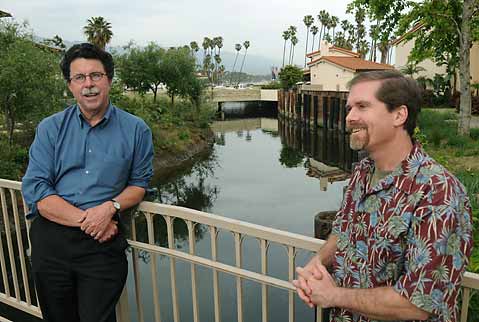Mission Creek Flood Control Project Gets Final Okay
Proposal Would Offer More Eco-Friendly Solution Than Those Previous

A controversial flood control project that was first unveiled in 1962 won final approval by the California Coastal Commission this past Thursday afternoon with notably little comment.
On the table is a plan that would provide a more environmentally sensitive project than the one first proposed for lower Mission Creek. The good news is that City Hall and the County of Santa Barbara now have all necessary permits to proceed with the new project, which aims to provide protection for those living along the Mission Creek watershed from Canon Perdido Street to where its mouth dumps into the ocean. The bad news is that the city and the county will have to pay for the project, which is now estimated to cost at least $60 million. That figure has doubled in the past six years, though city engineers note that cheaper bids have been coming in as a result of the ailing economy.
When all the work is done, the creek channel will range from 40- to 60-feet wide. Instead of the concrete walls and channel bottom initially proposed, it will now have a natural bottom, with natural vegetation lining the banks. The new flood control project is designed to handle flows of 3,500 cubic feet per second; by contrast, the floods of 1995 ran at 5,600 cubic feet per second. The Coastal Commission action was necessary to allow the city and the county to take over actual construction of the project; initially it was to have been a federal Army Corps of Engineers project.
Given the estimated cost, it’s likely the project will be built in stages. City Hall is taking responsibility for replacing many of the bridges that now span this stretch of creek. The federal government is providing grants for many of these new bridges. The grants cover 85 percent of the actual costs. The county had created an assessment district for lower Mission Creek many years ago, which now has reserves in excess of $20 million.
Initial plans for the flood control project were not so ecologically friendly. In the late 1980s, a blind cabinetmaker named Bruce Munson began a grassroots campaign against the concrete-bottomed, concrete-sided plans approved by City Hall, County Flood Control, and the Army Corps of Engineers. Munson managed to stir enough controversy that politicians like Harriet Miller-then a councilmember-and Tom Rogers-now deceased but then a county supervisor-took note. They helped get funding to study greener alternatives.
It was the Army Corps itself, however, that cooked the original plan’s goose. When subjected to actual modeling tests in 1993, the Santa Barbara proposal proved a disaster. The modeling study demonstrated that unless vast debris catch basins were built in Rocky Nook Park, the Army Corps proposal would make matters worse, not better, in the event of a flood. That conclusion ended the bickering between property owners and politicos clamoring for the Army Corps’ “quick fix” and those seeking a more environmentally sensitive alternative. The two sides spent many months hashing out an alternative plan acceptable to all. But with the election of George W. Bush, 9/11, the War in Iraq, and all the deficit spending during the past eight years, there was precious little interest-or funding-available for Santa Barbara’s Mission Creek project.



